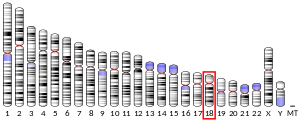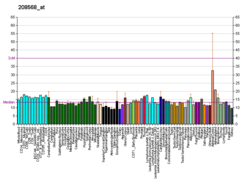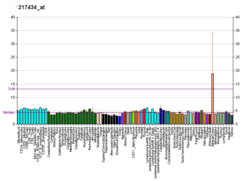| MC2R | |||||||||||||||||||||||||||||||||||||||||||||||||||
|---|---|---|---|---|---|---|---|---|---|---|---|---|---|---|---|---|---|---|---|---|---|---|---|---|---|---|---|---|---|---|---|---|---|---|---|---|---|---|---|---|---|---|---|---|---|---|---|---|---|---|---|
| Identifiers | |||||||||||||||||||||||||||||||||||||||||||||||||||
| Aliases | MC2R, ACTHR, melanocortin 2 receptor | ||||||||||||||||||||||||||||||||||||||||||||||||||
| External IDs | OMIM: 607397; MGI: 96928; HomoloGene: 444; GeneCards: MC2R; OMA:MC2R - orthologs | ||||||||||||||||||||||||||||||||||||||||||||||||||
| |||||||||||||||||||||||||||||||||||||||||||||||||||
| |||||||||||||||||||||||||||||||||||||||||||||||||||
| |||||||||||||||||||||||||||||||||||||||||||||||||||
| |||||||||||||||||||||||||||||||||||||||||||||||||||
| |||||||||||||||||||||||||||||||||||||||||||||||||||
| Wikidata | |||||||||||||||||||||||||||||||||||||||||||||||||||
| |||||||||||||||||||||||||||||||||||||||||||||||||||
The adrenocorticotropic hormone receptor or ACTH receptor also known as the melanocortin receptor 2 or MC2 receptor is a type of melanocortin receptor (type 2) which is specific for ACTH. A G protein–coupled receptor located on the external cell plasma membrane, it is coupled to Gαs and upregulates levels of cAMP by activating adenylyl cyclase. The ACTH receptor plays a role in immune function and glucose metabolism.
Structure
ACTH receptors are the shortest of the melanocortin receptor family and are the smallest known G-coupled receptors. Both human and bovine ACTH receptors are synthesized as 297 residue long proteins with 81% sequence homology. There are currently no available protein X-ray crystallography structures for the ACTH receptor available in the Protein Data Bank; while the ACTH receptor and the β2 adrenergic receptor are relatively distantly-related with a sequence identity of approximately 26%, MC2R investigators such as David Fridmanis have assumed that the folded surfaces of both receptors that are responsible for binding Gαs should be very similar and use conserved motifs.
The full length sequence of MC2R includes seven hydrophobic domains that are predicted as transmembrane segments. In the third intracellular loop of the receptor a protein kinase A and protein kinase c phosphorylation motifs have been detected. ACTH receptors also require the binding of melanocortin-2 receptor accessory protein-1 (MRAP1) without which ACTH receptors cannot bind ACTH. Without MRAP, the receptor is degraded in the endoplasmic reticulum, but with MRAP, the receptor is glycosylated and expressed on the cell plasma membrane.
Ligands
MCR's have both endogenous agonists and antagonists.
Agonists
α-MSH and ACTH are both peptides derived from processed POMC, and both activate the other MCR's, but ACTH is the only agonist ligand for MC2R (ACTH receptor). This suggests that there is more protein-related specificity for binding MC2R.
Antagonists
Agouti-related protein and Agouti-signaling protein are antagonist peptides to MC2R.
Tissue and subcellular localization
ACTH receptor is primarily found in the zona fasciculata of the human adrenal cortex. Binding of the receptor by ACTH stimulates the production of glucocorticoids (GCs)—by contrast, aldosterone production from the zona glomerulosa is stimulated primarily by angiotensin II. ACTH receptors are also expressed in the skin, and in both white and brown adipocytes, and is expressed in greater concentrations when adipose cells differentiate.
It is well known that levels of corticosterone (CORT, cortisol in humans) secretion demonstrate a circadian rhythm, highly regulated by effects of the suprachiasmatic nucleus, with higher levels in the early evening and lower levels in the morning. ACTH levels, ACTH receptor expression, and MRAP1 expression also demonstrate circadian rhythm, with ACTH secretion and MRAP expression highest in the evening, suggesting that MRAP expression is responsible for CORT secretory regulation. However, with exposure to constant light, the rhythmic expression of the ACTH receptor and MRAP genes reversed, suggesting ACTH-independent signalling pathways for MRAP and ACTH receptor transcription and expression.
Clinical significance
The ACTH receptor plays a role in glucose metabolism when expressed in white adipose cells. When bound to ACTH, a short-term insulin-resistance occurs, and it stimulates lipolysis via hormone sensitive lipase. Demonstrated in mice, ACTH promotes lipolysis in response to increased energy demand, notably in times of stress. Lipolytic activity due to melanocortin receptors has been demonstrated in several types of test animals: rats and hamsters primarily respond to ACTH, rabbits respond to alpha and beta MSH's (therefore not using the ACTH receptor), and guinea pigs responding to both ACTH and other MSH's. In humans, ACTH has little lipolytic effect on adipose tissue.
ACTH receptor activation also influences immune function. Melanocortins, including ACTH, have anti-inflammatory effects which can be exerted via GC-dependent and -independent pathways. The GC-dependent pathway activates ACTH receptors to increase levels of cortisol which bind GC receptors. Via genomic and faster non-genomic pathways, this causes, among other immune responses, a reduction in leukocyte and neutrophil infiltration, cytokine production, especially of cytokine CXCL-1, and increased phagocytosis of apoptotic neutrophils. These profound anti-inflammatory effects and the ability to increase GC's are why ACTH therapy is still used today. It is often used as treatment for infantile spasms, multiple sclerosis, nephrotic syndrome, gout, ulcerative colitis, Crohn's disease, rheumatoid arthritis, and systemic lupus erythematosus. This is problematic long-term and can lead to ACTH-receptor pathway-related side effects including: Cushing's syndrome, fluid retention, glaucoma, and cardiovascular disorders.
Mutations in this receptor cause familial glucocorticoid deficiency (FGD) type 1, in which patients have high levels of serum ACTH and low levels of cortisol. Mutation of the receptor gene causes 25% of FGD, and mutation on the MRAP gene causes 20% of FGD. Mutations of ACTH can also contribute to this pathology: mutation of the "message sequence" inhibits cAMP production when bound to the ACTH receptor, and mutation of the "address sequence" inhibits binding to the receptor altogether.
Evolution
Paralogue
Source:
- MC4R
- MC3R
- MC5R
- MC1R
- GPR12
- S1PR1
- S1PR2
- LPAR1
- CNR1
- S1PR3
- GPR6
- GPR3
- S1PR5
- LPAR3
- S1PR4
- CNR2
- GPR119
- LPAR2
See also
References
- ^ GRCh38: Ensembl release 89: ENSG00000185231 – Ensembl, May 2017
- ^ GRCm38: Ensembl release 89: ENSMUSG00000045569 – Ensembl, May 2017
- "Human PubMed Reference:". National Center for Biotechnology Information, U.S. National Library of Medicine.
- "Mouse PubMed Reference:". National Center for Biotechnology Information, U.S. National Library of Medicine.
- Beuschlein F, Fassnacht M, Klink A, Allolio B, Reincke M (March 2001). "ACTH-receptor expression, regulation and role in adrenocortial tumor formation". European Journal of Endocrinology. 144 (3): 199–206. doi:10.1530/eje.0.1440199. PMID 11248736.
- ^ Fridmanis D, Roga A, Klovins J (6 February 2017). "ACTH Receptor (MC2R) Specificity: What Do We Know About Underlying Molecular Mechanisms?". Frontiers in Endocrinology. 8: 13. doi:10.3389/fendo.2017.00013. PMC 5292628. PMID 28220105.
- Hanukoglu I, Feuchtwanger R, Hanukoglu A (November 1990). "Mechanism of corticotropin and cAMP induction of mitochondrial cytochrome P450 system enzymes in adrenal cortex cells" (PDF). The Journal of Biological Chemistry. 265 (33): 20602–8. doi:10.1016/S0021-9258(17)30545-8. PMID 2173715.
- Elias LL, Clark AJ (October 2000). "The expression of the ACTH receptor". Brazilian Journal of Medical and Biological Research. 33 (10): 1245–8. doi:10.1590/S0100-879X2000001000015. PMID 11004726.
- "ACTH - Clinical: Adrenocorticotropic Hormone (ACTH), Plasma". www.mayomedicallaboratories.com. Retrieved 2016-10-25.
- ^ Gallo-Payet N (May 2016). "60 YEARS OF POMC: Adrenal and extra-adrenal functions of ACTH". Journal of Molecular Endocrinology. 56 (4): T135-56. doi:10.1530/JME-15-0257. PMID 26793988.
- ^ Raikhinstein M, Zohar M, Hanukoglu I (February 1994). "cDNA cloning and sequence analysis of the bovine adrenocorticotropic hormone (ACTH) receptor". Biochimica et Biophysica Acta (BBA) - Molecular Cell Research. 1220 (3): 329–32. doi:10.1016/0167-4889(94)90157-0. PMID 8305507.
- Sebag JA, Hinkle PM (January 2009). "Regions of melanocortin 2 (MC2) receptor accessory protein necessary for dual topology and MC2 receptor trafficking and signaling". The Journal of Biological Chemistry. 284 (1): 610–8. doi:10.1074/jbc.M804413200. PMC 2610514. PMID 18981183.
- Cai M, Hruby VJ (2016). "The Melanocortin Receptor System: A Target for Multiple Degenerative Diseases". Current Protein & Peptide Science. 17 (5): 488–96. doi:10.2174/1389203717666160226145330. PMC 5999398. PMID 26916163.
- Iwen KA, Senyaman O, Schwartz A, Drenckhan M, Meier B, Hadaschik D, Klein J (March 2008). "Melanocortin crosstalk with adipose functions: ACTH directly induces insulin resistance, promotes a pro-inflammatory adipokine profile and stimulates UCP-1 in adipocytes". The Journal of Endocrinology. 196 (3): 465–72. doi:10.1677/JOE-07-0299. PMID 18310442. S2CID 207255622.
- ^ Park SY, Walker JJ, Johnson NW, Zhao Z, Lightman SL, Spiga F (May 2013). "Constant light disrupts the circadian rhythm of steroidogenic proteins in the rat adrenal gland". Molecular and Cellular Endocrinology. Fifteenth Conference on the Adrenal Cortex (Adrenal 2012) League City, Texas June 19 – 22, 2012. 371 (1–2): 114–23. doi:10.1016/j.mce.2012.11.010. PMID 23178164. S2CID 32479803.
- Møller CL, Raun K, Jacobsen ML, Pedersen TÅ, Holst B, Conde-Frieboes KW, Wulff BS (July 2011). "Characterization of murine melanocortin receptors mediating adipocyte lipolysis and examination of signalling pathways involved" (PDF). Molecular and Cellular Endocrinology. 341 (1–2): 9–17. doi:10.1016/j.mce.2011.03.010. PMID 21616121. S2CID 31837693.
- Boston BA (October 1999). "The role of melanocortins in adipocyte function". Annals of the New York Academy of Sciences. 885 (1): 75–84. Bibcode:1999NYASA.885...75B. doi:10.1111/j.1749-6632.1999.tb08666.x. PMID 10816642. S2CID 41988113.
- ^ Montero-Melendez T (May 2015). "ACTH: The forgotten therapy". Seminars in Immunology. Resolution of inflammation. 27 (3): 216–26. doi:10.1016/j.smim.2015.02.003. PMID 25726511.
- Clark AJ, McLoughlin L, Grossman A (February 1993). "Familial glucocorticoid deficiency associated with point mutation in the adrenocorticotropin receptor". Lancet. 341 (8843): 461–2. doi:10.1016/0140-6736(93)90208-X. PMID 8094489. S2CID 11356360.
- Tsigos C, Arai K, Hung W, Chrousos GP (November 1993). "Hereditary isolated glucocorticoid deficiency is associated with abnormalities of the adrenocorticotropin receptor gene". The Journal of Clinical Investigation. 92 (5): 2458–61. doi:10.1172/JCI116853. PMC 288430. PMID 8227361.
- "GeneCards®: The Human Gene Database".
Further reading
- Cone RD, Mountjoy KG, Robbins LS, Nadeau JH, Johnson KR, Roselli-Rehfuss L, Mortrud MT (May 1993). "Cloning and functional characterization of a family of receptors for the melanotropic peptides". Annals of the New York Academy of Sciences. 680 (1): 342–63. Bibcode:1993NYASA.680..342C. doi:10.1111/j.1749-6632.1993.tb19694.x. PMID 8390157. S2CID 35656702.
- Allolio B, Reincke M (1997). "Adrenocorticotropin receptor and adrenal disorders". Hormone Research. 47 (4–6): 273–8. doi:10.1159/000185476. PMID 9167964.
- Tatro JB (1997). "Receptor biology of the melanocortins, a family of neuroimmunomodulatory peptides". Neuroimmunomodulation. 3 (5): 259–84. doi:10.1159/000097281. PMID 9218248.
- Mountjoy KG, Robbins LS, Mortrud MT, Cone RD (August 1992). "The cloning of a family of genes that encode the melanocortin receptors". Science. 257 (5074): 1248–51. Bibcode:1992Sci...257.1248M. doi:10.1126/science.1325670. PMID 1325670.
- Clark AJ, McLoughlin L, Grossman A (February 1993). "Familial glucocorticoid deficiency associated with point mutation in the adrenocorticotropin receptor". Lancet. 341 (8843): 461–2. doi:10.1016/0140-6736(93)90208-X. PMID 8094489. S2CID 11356360.
- Tsigos C, Arai K, Hung W, Chrousos GP (November 1993). "Hereditary isolated glucocorticoid deficiency is associated with abnormalities of the adrenocorticotropin receptor gene". The Journal of Clinical Investigation. 92 (5): 2458–61. doi:10.1172/JCI116853. PMC 288430. PMID 8227361.
- Gantz I, Tashiro T, Barcroft C, Konda Y, Shimoto Y, Miwa H, Glover T, Munzert G, Yamada T (October 1993). "Localization of the genes encoding the melanocortin-2 (adrenocorticotropic hormone) and melanocortin-3 receptors to chromosomes 18p11.2 and 20q13.2-q13.3 by fluorescence in situ hybridization" (PDF). Genomics. 18 (1): 166–7. doi:10.1006/geno.1993.1448. hdl:2027.42/30538. PMID 8276410.
- Gantz I, Konda Y, Tashiro T, Shimoto Y, Miwa H, Munzert G, Watson SJ, DelValle J, Yamada T (April 1993). "Molecular cloning of a novel melanocortin receptor". The Journal of Biological Chemistry. 268 (11): 8246–50. doi:10.1016/S0021-9258(18)53088-X. PMID 8463333.
- Naville D, Barjhoux L, Jaillard C, Faury D, Despert F, Esteva B, Durand P, Saez JM, Begeot M (April 1996). "Demonstration by transfection studies that mutations in the adrenocorticotropin receptor gene are one cause of the hereditary syndrome of glucocorticoid deficiency". The Journal of Clinical Endocrinology and Metabolism. 81 (4): 1442–8. doi:10.1210/jcem.81.4.8636348. PMID 8636348.
- Naville D, Jaillard C, Barjhoux L, Durand P, Bégeot M (January 1997). "Genomic structure and promoter characterization of the human ACTH receptor gene". Biochemical and Biophysical Research Communications. 230 (1): 7–12. doi:10.1006/bbrc.1996.5911. PMID 9020063.
- Yang YK, Ollmann MM, Wilson BD, Dickinson C, Yamada T, Barsh GS, Gantz I (March 1997). "Effects of recombinant agouti-signaling protein on melanocortin action". Molecular Endocrinology. 11 (3): 274–80. doi:10.1210/mend.11.3.9898. PMID 9058374.
- Naville D, Barjhoux L, Jaillard C, Saez JM, Durand P, Bégeot M (April 1997). "Stable expression of normal and mutant human ACTH receptor: study of ACTH binding and coupling to adenylate cyclase". Molecular and Cellular Endocrinology. 129 (1): 83–90. doi:10.1016/S0303-7207(97)04043-4. PMID 9175632. S2CID 24112827.
- Penhoat A, Naville D, Jaillard C, Durand P, Bégeot M (May 1997). "Presence of multiple functional polyadenylation signals in the 3′-untranslated region of human corticotropin receptor cDNA". Biochimica et Biophysica Acta (BBA) - Molecular Cell Research. 1356 (3): 249–52. doi:10.1016/S0167-4889(97)00031-1. PMID 9194567.
- Ishii T, Ogata T, Sasaki G, Sato S, Kinoshita EI, Matsuo N (September 2000). "Novel mutations of the ACTH receptor gene in a female adult patient with adrenal unresponsiveness to ACTH". Clinical Endocrinology. 53 (3): 389–92. doi:10.1046/j.1365-2265.2000.01040.x. PMID 10971458. S2CID 418654.
- Flück CE, Martens JW, Conte FA, Miller WL (September 2002). "Clinical, genetic, and functional characterization of adrenocorticotropin receptor mutations using a novel receptor assay". The Journal of Clinical Endocrinology and Metabolism. 87 (9): 4318–23. doi:10.1210/jc.2002-020501. PMID 12213892.
- Swords FM, Baig A, Malchoff DM, Malchoff CD, Thorner MO, King PJ, Hunyady L, Clark AJ (December 2002). "Impaired desensitization of a mutant adrenocorticotropin receptor associated with apparent constitutive activity". Molecular Endocrinology. 16 (12): 2746–53. doi:10.1210/me.2002-0099. PMID 12456795.
- Roy S, Rached M, Gallo-Payet N (July 2007). "Differential regulation of the human adrenocorticotropin receptor by human MC2R accessory protein isoforms alpha and beta in isogenic human embryonic kidney 293 cells". Molecular Endocrinology. 21 (7): 1656–69. doi:10.1210/me.2007-0041. PMID 17456795.
External links
- "Melanocortin Receptors: MC2". IUPHAR Database of Receptors and Ion Channels. International Union of Basic and Clinical Pharmacology. Archived from the original on 2016-03-03. Retrieved 2007-07-23.
- MC2+Receptor at the U.S. National Library of Medicine Medical Subject Headings (MeSH)
- Human MC2R genome location and MC2R gene details page in the UCSC Genome Browser.
| Melanocortin receptor modulators | |
|---|---|
| MC1 |
|
| MC2 | |
| MC3 | |
| MC4 |
|
| MC5 |
|
| Unsorted | |
| Others |
|





